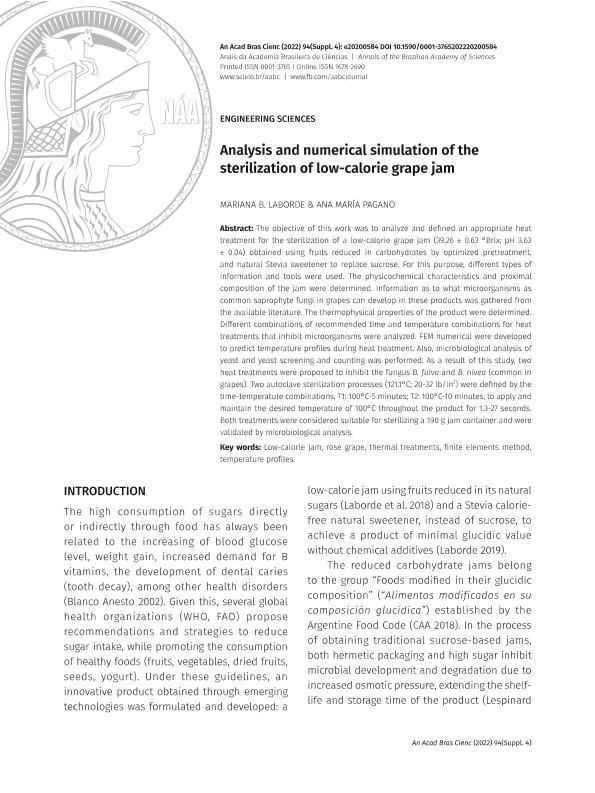Artículo
Analysis and numerical simulation of the sterilization of low-calorie grape jam
Fecha de publicación:
03/2022
Editorial:
Academia Brasileira de Ciencias
Revista:
Anais da Academia Brasileira de Ciencias
ISSN:
0001-3765
e-ISSN:
1678-2690
Idioma:
Inglés
Tipo de recurso:
Artículo publicado
Clasificación temática:
Resumen
The objective of this work was to analyze and defined an appropriate heat treatment for the sterilization of a low-calorie grape jam (39.260.63 ºBrix; pH 3.630.04) obtained using fruits reduced in carbohydrates by optimized pretreatment, and natural Stevia sweetener to replace sucrose. For this purpose, different types of information and tools were used. The physicochemical characteristics and proximal composition of the jam were determined. Information as to what microorganisms as common saprophyte fungi in grapes can develop in these products was gathered from the available literature. The thermophysical properties of the product were determined. Different combinations of recommended time and temperature combinations for heat treatments that inhibit microorganisms were analyzed. FEM numerical were developed to predict temperature profiles during heat treatment. Also, microbiological analysis of yeast and yeast screening and counting was performed. As a result of this study, two heat treatments were proposed to inhibit the fungus B. fulva and B. nivea (common in grapes). Two autoclave sterilization processes (121.1ºC; 20-32 lb/in2) were defined by the time-temperature combinations, T1: 100ºC-5 minutes; T2: 100ºC-10 minutes, to apply and maintain the desired temperature of 100ºC throughout the product for 1.3-27 seconds. Both treatments were considered suitable for sterilizing a 190 g jam container and were validated by microbiological analysis.
Archivos asociados
Licencia
Identificadores
Colecciones
Articulos(INCUAPA)
Articulos de INVESTIGACIONES ARQUEOLOGICAS Y PALEONTOLOGICAS DEL CUATERNARIO PAMPEANO
Articulos de INVESTIGACIONES ARQUEOLOGICAS Y PALEONTOLOGICAS DEL CUATERNARIO PAMPEANO
Citación
Laborde, Mariana Belén; Pagano, Ana Maria; Analysis and numerical simulation of the sterilization of low-calorie grape jam; Academia Brasileira de Ciencias; Anais da Academia Brasileira de Ciencias; 94; 3-2022; 1-21
Compartir
Altmétricas




